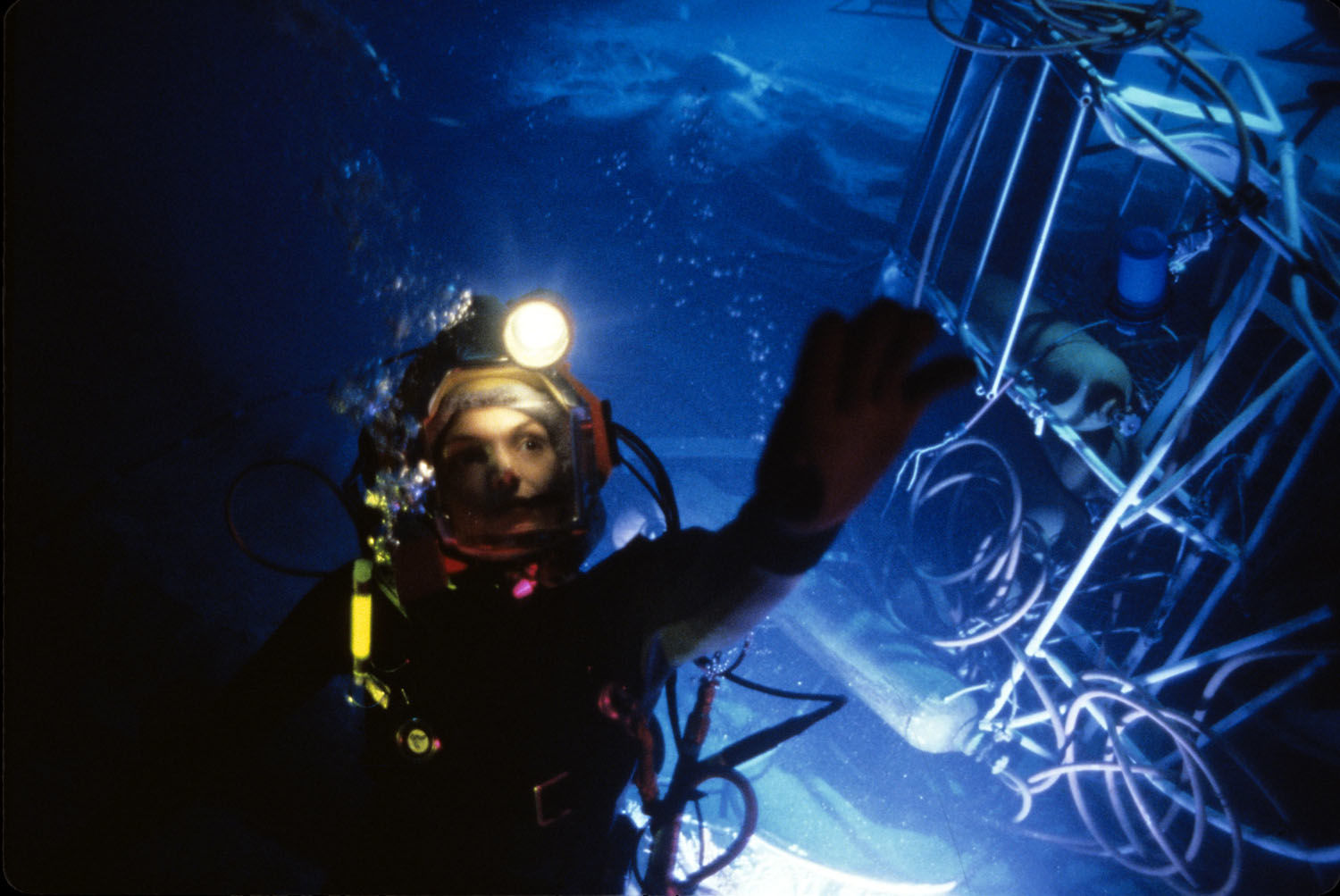Create a free profile to get unlimited access to exclusive videos, sweepstakes, and more!
The Abyss turns 30: How James Cameron pushed boundaries and almost killed his actors

There are certain things you can always count on James Cameron for. One, his films will always make a ridiculous amount of money. Two, said movies will play indelible parts in defining the pop culture of their time. And three, the actors appearing in them will probably have to go through hell and back in making it all happen.
With a worldwide box office gross of $6.222 billion to his name, James Cameron's films have made more money than those of Christopher Nolan, Tim Burton, and David Yates of the Harry Potter series. Not too shabby, considering he’s only made nine films in his entire career. Yet those nine films have been groundbreaking additions to the world of the blockbuster genre. His willingness to push the boundaries of special effects in their integration with the traditional tools of cinematic storytelling has made him an icon in a business that is quick to kill its idols. Off-camera, he's just as adventurous, having reached the bottom of the Mariana Trench and become the first person to do so in a solo descent. But you probably know him best for the Terminator movies, or Avatar, or Titanic. When you think of Cameron, you see bombast for the big screen, dizzying spectacles that defy belief and pave the way for the medium’s future. Now, James Cameron has never truly made a flop — unless you count his directorial debut, Piranha II: The Spawning, but by and large his films are all talked about fondly and as hugely impactful pieces of work.
But then there’s The Abyss, which turns 30 this month.
In many ways, The Abyss is the perfect exemplification of what it means to be A James Cameron Movie: It's a technical marvel that prizes innovation over storytelling or character, one with behind-the-scenes as dramatic and death-defying as anything that happens in the plot. By Cameron’s own standards, it is simultaneously a staggering achievement and kind of a let-down. The movie debuted at number two at the domestic box office, just behind the comedy Parenthood, and went on to gross $90 million from a budget of around $45 million — not disastrous numbers but still a soft success compared to Aliens and The Terminator. But for a man whose career is so heavily defined by productions tailor-made for people with death wishes, The Abyss may be the most bonkers movie Cameron ever made.
The Abyss is the story of a Navy SEAL team sent to salvage a nuclear submarine that was sunk under mysterious circumstances and is being targeted by the Soviets. Accompanying Virgil "Bud" Brigman, the mission's foreman, is Dr. Lindsey Brigman, an engineer who helped to design the drilling platform being used as their base of operations. She's also Bud's ex-wife. As the team struggles with floods, tensions, and the risk of hypothermia, it soon becomes clear that there's something much bigger going on beneath the surface of the world.
Forty percent of the film's principal photography (not including the CGI work) took place underwater. That one step required a massive amount of preparation and innovation. For example, the cast and crew trained for a week in the Cayman Islands on underwater diving before production began. In order to film underwater and communicate with his team, Cameron had his production company design entirely new equipment for the job. Original plans to shoot the movie in the Bahamas, where the story took place, were scuppered because Cameron needed to have total control over the water, something that's not easy to do even in a tank. The largest tank of water available for such productions is in Malta, but it wasn't big enough for Cameron. Instead, he turned to an abandoned nuclear power plant in South Carolina, which featured a former reactor containment vessel that could hold over 7.5 million gallons of water and took five days to fill.
In the film, the concept of liquid breathing is a key part of the story, used by Ed Harris' character as a way to dive thousands of feet without compressing. This is a real thing but more theory than reality for humans. It has been tested on animals, and one rat in the film was a real test subject for liquid breathing, but when it came time for Harris to film the scene, he simply held his breath inside a helmet full of liquid as he was towed beneath the surface. Shockingly, this wasn’t a great experience for Harris.
It wasn’t exactly a thrill for the rest of the cast either, all of whom were shooting 70-hour weeks for six months. Mary Elizabeth Mastrantonio had a physical and emotional breakdown on set, and Harris admitted he broke into a fit of sobbing while driving home one day because of the stress. At one point, a lightning storm ripped a hole in the black tarp covering the tank, and since repairing it took too much time and production was already running over, they started shooting at night. Too much exposure to chlorine burned divers' skin and turned their hair white. Tensions came to a boiling point during one scene, where Mastrantonio's character sacrifices herself before being revived by Harris.
As Harris explained to Entertainment Weekly: "We were guinea pigs, in a way, Jim wasn’t quite sure how this was all gonna go down… [in the drowning scene I was] screaming at her to come back and wake up, and I was slapping her across the face and I see that they’ve run out of film in the camera — there’s a light on the camera — and nobody had said anything. And Mary Elizabeth stood up and said, ‘We are not animals!” and walked off the set. They were going to let me just keep slapping her around!"
At one point during production, even Cameron himself almost died. While at the bottom of this gargantuan underwater set, the AD who was supposed to monitor the director's oxygen levels was suddenly off the clock and Cameron knew he had to get to air quickly. He stripped off all his gear, including his helmet, and tried to rise to safety. A safety diver went to help by offering him the spare breathing regulator, but it was faulty and Cameron ended up accidentally sucking in a lot of water. Cameron struggled to get free, but the safety diver assumed he was distressed and kept a hold of him until Cameron punched him in the face. He soon let go and Cameron got to safety.
And just to make things that wee bit more unbearable? The on-screen divorce of the main characters was mirrored in real life, as Cameron and producer Gale Anne Hurd divorced while the film was in pre-production.
So what was it all for? What is the final result?
The Abyss is a curious movie, one that’s chock full of excitement and visual thrills that has a truly wild ending. Generally speaking, Cameron is not a director concerned with a sturdy narrative arc for his characters, but he’s also a sentimentalist at heart, not unlike blockbuster cohorts Steven Spielberg and George Lucas. That can work. Titanic is still, in my humble opinion, his best film in large part because he takes the melodrama of that central romance as seriously as he does the spectacle of the sinking ship. With The Abyss, it’s a much less satisfying balance, and the film would have seriously benefitted from Cameron simply casting aside his allusions and committing to having it be a technical experience over an emotional one. However, the main problem is the shift in genre. When The Abyss goes full sci-fi, it oddly makes the movie much less interesting. The thrills lessen almost immediately and the sentimental approach doesn’t pay off. Everything gets silly but not in a self-aware manner that can be mined for fun. The actors are trying their hardest and boy is their agony over this nightmare of a shoot evident, but they can only do so much. They, like everything else, are overwhelmed.
After the theatrical release, Cameron would later go on to dramatically change much of the movie with his director's cut. A solid half hour was cut from the running time, major set pieces were altered or removed, and Industrial Light & Magic was brought on board to complete CGI sequences that they didn't have the tech for years prior. The end result is a movie that was far better received by critics, although it still has its problems. Of course, it's not like Cameron's reputation needed to be rebuilt or anything in the 1990s. The dude did make Titanic, after all.
As Cameron continues the seemingly never-ending production of the first two Avatar sequels (four are planned), he maintains his identity as Hollywood's foremost adventuring mad-man. For Avatar 2, many of the actors were taught how to free-dive for what he promises will be further boundary-pushing technical feats in the capturing of underwater scenes. If the cast needs any advice on how to survive Hurricane Cameron, the cast of The Abyss would certainly understand.
The views and opinions expressed in this article are the author's, and do not necessarily reflect those of SYFY WIRE, SYFY, or NBC Universal.














